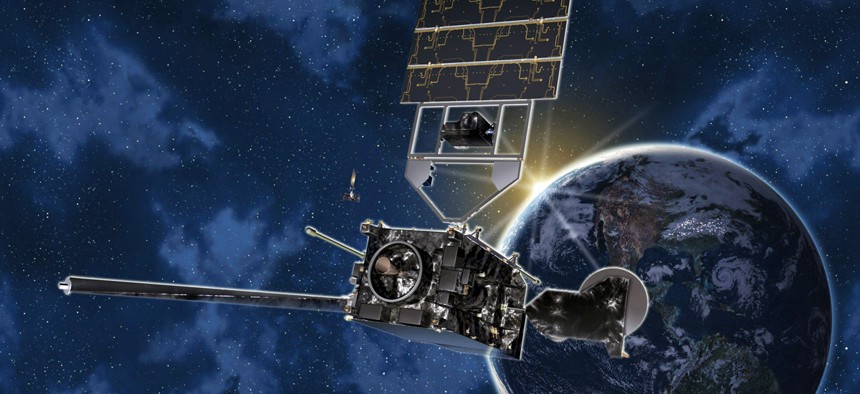$11 Billion Next-Gen Weather Satellite Launch Delayed

Artist's conception of GOES-R environmental satellite. NOAA
“Schedule risks” found by NOAA, NASA and main contractor Lockheed Martin have slipped the launch again to sometime in fall, likely October.
The launch of the first of the National Oceanic and Atmospheric Administration’s next-generation geostationary weather satellites has been delayed for the second time in as many years.
The first GOES-R satellite (Geostationary Operational Environmental Satellite) had pushed its original launch date from October 2015 to March 2016, and “schedule risks” found by NOAA, NASA and main contractor Lockheed Martin have slipped the launch again to sometime in the fall, likely October.
NOAA, NASA and Lockheed Martin identified schedule risks that have affected the current launch date for GOES-R, NOAA spokesman John Leslie told Nextgov.
“After extensive review by NASA and Lockheed Martin, NOAA has decided it can best avoid these risks to the mission by moving the launch date from March 2016 and to pursue a potential launch slot in the fall 2016,” he said. “We expect a decision on this in the very near future. NOAA will continue working with its partners to conduct thorough reviews of the GOES-R system and revise the satellite delivery schedule during the coming weeks.”
The launch delay isn’t particularly surprising. Despite timely instrumentation deliveries, GOES-R has had management problems for quite some time.
A slew of audits from both the Commerce Department’s inspector general and the Government Accountability Office in recent years describe inadequate contracting support and other issues inherent in the GOES-R project.
Another hint came during GAO testimony before a House Committee on Science, Space and Technology’s subcommittee in February. Dave Powner, director of information technology management issues at GAO, told the subcommittee NOAA’s decision to perform “24/7 testing” indicated something amiss in the project.
What makes the delay important, though, is how it affects NOAA’s weather-forecasting efforts moving forward.
NOAA estimates the four satellites developed in the GOES-R series will cost $10.9 billion through 2036.
Once operational, GOES-R satellites, which provide broad, continuously updated coverage of atmospheric data and weather conditions over land and oceans, are to replace an existing crop of two operational and one backup GOES satellite.
GOES satellites produce the lion’s share of weather data that feed forecasting models for scientists on the ground.
Today’s GOES satellites are rapidly approaching the end of their projected life cycles, with one meeting the end of its life cycle this year. This risk, in addition to problems NOAA has had developing its next-generation polar orbiting satellite program, landed NOAA’s environmental satellite programs on GAO’s biennial High-Risk List.
“Because of the importance of GOES satellite data, NOAA’s policy is to have two operational satellites and one backup satellite in orbit at all times,” Powner said in his Feb. 22 testimony. “NOAA is facing a period of up to 17 months when it will not have a backup satellite in orbit.”
Another six-month delay extends the risk period to approximately two years.
Having a backup geostationary satellite proved integral only three years ago, when a micrometeoroid struck one of the three GOES satellites, knocking it offline for a week. NOAA maintained continuity of operations, however, by activating its backup during that period.
Were a similar incident to occur with no backup geostationary satellite in place, NOAA weather data collection – and forecasts on the ground – would be negatively affected. The launch delay makes that uncomfortable possibility more likely.



